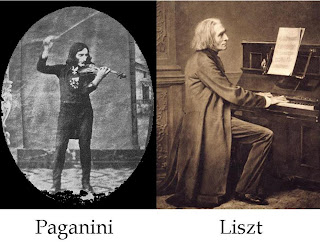Long-Haired Musicians
Before the 1960s, when you talked about “long-haired”
musicians, you were referring to Classical
musicians. Especially in their early
1900s (as men’s hairstyles grew shorter), classical musicians stood out not
only for their talent, but also their flowing manes. The ultimate example from this era is the
Polish pianist, Ignaz Paderewski.
But he was hardly the first. Composers such as Johannes Brahms and the pianist Emil von Sauer sported the long-haired look in the 1800s and early 1900s. The grandfather of the trend was Ludwig van Beethoven, who very early on eschewed wigs and whose unruly locks became part of his legend.
Even in our own time, many classical musicians,
including the Russian pianists Lazar Berman and Evgeny Kissin have kept the
trend going.
But the guy who really set the style, whose tumbling locks were part of his out-sized legend, was the composer and piano virtuoso, Franz Liszt.
In the 1970s and 80s, much effort was expended in
trying to market Liszt like a rock star (He slept with a lot of women! He used opium! His concerts were all about showmanship! Crowds mobbed him!) All these things were true of master showman
Liszt, who invented the piano recital (prior to him, no pianist would have
dared to put on a concert of just piano music.)
He was a sensation and scandal, part devil and part god; one minute
absconding with a married countess and the next taking minor religious orders
in the Church.
Liszt was part of mad world of music in Paris in the
1830s and 40s. He was friends with
Berlioz, Chopin and Wagner and was influential in the advance of Romantic
music. Unfortunately, Liszt died before
the advent of recording, but many of his greatest pupils, including von Sauer,
Moritz Rosenthal and Eugen d’Albert left recordings of Liszt works and give us
some idea of what he must have sounded like.
So here’s a sampler of Liszt’s music for a rainy
Tuesday. First we have Liszt’s pupil
Emil von Sauer playing the end of Liszt’s Piano Concerto No. 1 in E-Flat
Major. This recording was made in 1938
when von Sauer was 76!
Here’s the incomparable Vladimir Horowitz playing Liszt’s
Consolation No. 3.
And now some orchestral music. The Romantics were big on music that depicted
things; nature, books, paintings, etc.
Liszt was well within this trend, composing symphonic poems and a
symphony based on Dante’s Divine Comedy.
Here’s Liszt’s depiction of Dante’s Inferno from the Divine Comedia
Symphony.
Finally, here’s the Liszt piece that most people know –
the famous Hungarian Rhapsody No. 2 in C-Sharp Minor. Here it is played by another renowned
composer-pianist, the great Sergei Rachmaninoff (and as bonus, it includes the
idiosyncratic cadenza that Rachminoff composed for the Rhapsody.)
And here’s the real bonus, the version of the Hungarian
Rhapsody most of us know!
Love those long-haired musicians!








No comments:
Post a Comment